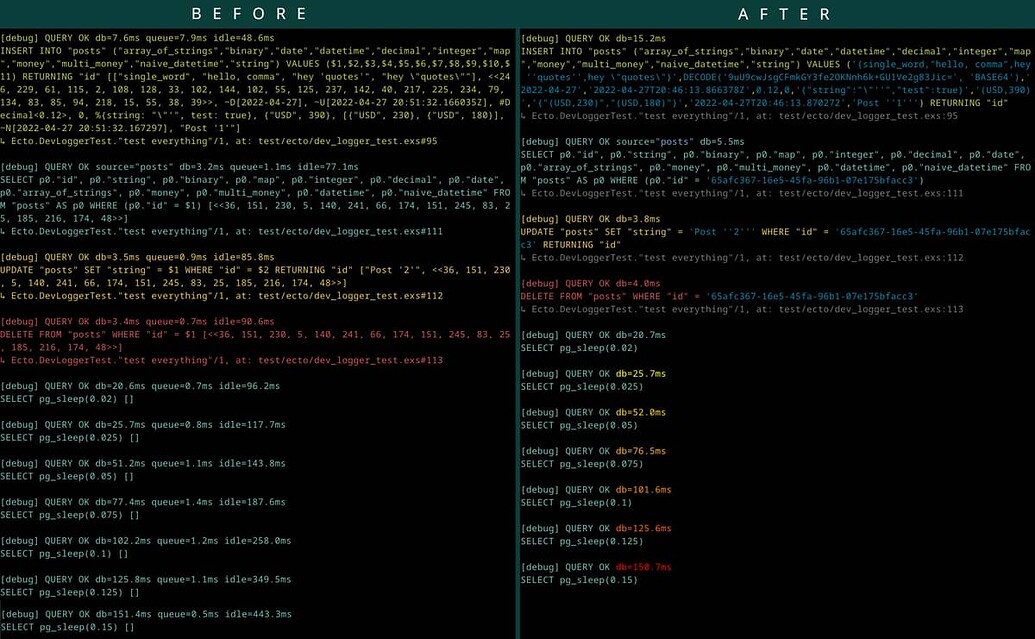
We now have framework for building dynamic queries that is extremely easy toĭo you want to add further operators, e.g. to_existing_atom (field ), filter ) defp build_condition (field, value ) when is_atom (value ), do: dynamic (, field (c, ^field ) = ^value ) Here’s an example from the MongoDB documentation:įilter = % defp build_condition (field_or_operator, filter ) defp build_condition ( "$or", filter ), do: build_or (filter ) defp build_condition (field, filter ) when field in, do: build_condition (String. MongoDB have come up with a querying standard based
#Elixir ecto to sql how to
Ecto uses the same SQL keywords (from, where, select, and so on) with the semantics. 55 How to alter a column name in an Ecto model with a migration. So more bike-shedding lies ahead downįortunately, there is no need to reinvent the wheel here. If you're used to SQL, you will feel right at home with Ecto queries. But there is noĬommonly accepted standard for this and dealing with more complex filterĬonditions can quickly become cumbersome. There is good support for GraphQL in Elixir with Absinthe,īut GraphQL requires special tooling and this can actually make things moreĪnother opption is to build a RESTful API with filter support. In recent years, GraphQL has become a popular choice for many. That it can easily become an issue of bike-shedding.

There are many ways to design a querying API. This article is based on learnings from building Keila, a free/libre Open SourceĪlternative to MailChimp, written in Elixir.īe sure to check it out at keila.io! A Quick Word on Designing a Querying API The communication is based on an Adapter and the connection. Before You Continue Reading this Article … The repositories will allow the connection between a SQL database and the Elixir application. How to use it to build a querying API in the style of MongoDB. This article will introduce you to a little-known feature of Ecto and show you You even design such a querying API? And more importantly: How do compose those One of those challenges is finding a way to let users query your database orĪgain and again you’ll have to build a UI or an API in which users can compose queriesĭepending on your use-case, this can quickly become a complex endeavour. In the next part, we'll look at writing a simple query object, which will help use write safe dynamic SQL while staying relatively close to raw SQL.There are challenges that come up in almost every web application project. You should personalize and optimize this to fit your needs. You should keep in mind that this is only meant as a base template. ) end end, ) # optional parameters to pass to Postgrex affected! (tx, "update users set status = 'deleted' where id = $1", ) = 1 do DB.

This appears to be supported by both postgres and mysql (I’m using postgres). Using Ecto.Query Id like to be able to run a query and prepend a comment like this in Postges: / my comment / SELECT a.col FROM table a Ive tried 'where: fragment', but its not working well, and it makes for messy SQL. Which we can then use like so: alias MyApp. I’m attempting to replicate an INSERT SELECT in Ecto. Let's look at a basic example: defmodule MyApp do use Application def start (_type, _args ) do # Probably want to store this in a config # and load via Application.fetch_env!(:myapp, :db)ĭb_config = Ĭhildren = [ -> raise "transaction! rollback" Use Postgrex.query/4, Postgrex.query!/4 and ansaction/3.Use Postgrex.start_link to start a named connection process, probably as part of your root/application supervisor.
#Elixir ecto to sql driver
Add a dependency to Postgrex (the same driver used by Ecto).PostgreSQL, MySQL, Sqlite) within the same codebase. The only case where I'd consider a data mapping layer is if I had to support multiple databases (e.g. I want to keep this post objective, but I will say that, having used various data mapping patterns and tools, I've found that using SQL directly almost always results in simpler yet more flexible code. This can be the disclosure of sensitive data, modification of the database, or deletion of entire tables. Ecto is an official Elixir project providing a database wrapper and integrated query language. In this post we'll explore using PostgreSQL directly from an Elixir (or Phoenix) application. SQL injection is a type of attack against a web application, where some malicious input is parsed by the underlying database, resulting in an unauthorized operation being performed.


 0 kommentar(er)
0 kommentar(er)
